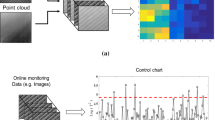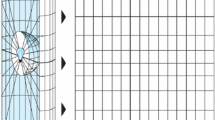Abstract
As sensor and measurement technologies advance, there is a continual need to adapt and develop new Statistical Process Control (SPC) techniques to effectively and efficiently take advantage of these new datasets. Currently high-density noncontact measurement technologies, such as 3D laser scanners, are being implemented in industry to rapidly collect point clouds consisting of millions of data points to represent a manufactured parts' surface. For their potential to be realized, SPC methods capable of handling these datasets need to be developed. This paper presents an approach for performing SPC using high-density point clouds. The proposed approach is based on transforming the high-dimensional point clouds into Non-Uniform Rational Basis Spline (NURBS) surfaces. The control parameters for these NURBS surfaces are then monitored using a surface monitoring technique. In this paper point clouds are simulated to determine the performance of the proposed approach under varying fault scenarios.












Similar content being viewed by others

References
Bao, L., Wang, K., & Jin, R. (2014). A hierarchical model for characterising spatial wafer variations. International Journal of Production Research, 52(6), 1827–1842.
Barari, A., Kishawy, H. A., Kaji, F., & Elbestawi, M. A. (2017). On the surface quality of additive manufactured parts. The International Journal of Advanced Manufacturing Technology, 89(5–8), 1969–1974.
Bersimis, S., Psarakis, S., & Panaretos, J. (2007). Multivariate statistical process control charts: an overview. Quality and Reliability Engineering International, 23(5), 517–554.
Colosimo, B. M., Mammarella, F., & Petro, S. (2010). Quality control of manufactured surfaces. Frontiers of Statistical Quality Control, 9, 55–70.
Cox, M. G. (1972). The numerical evaluation of B-splines. Journal of the Institute of Mathematics and its Applications, 15, 99–108.
De Boor, C. (1972). On calculating with B-Splines. Journal of Approximation Theory, 6, 52–60.
Gohari, H., & Barari, A. (2016). A quick deviation zone fitting in coordinate metrology of NURBS surfaces using principle component analysis. Measurement, 92, 352–364.
He, K., Zhang, M., Zuo, L., Alhwiti, T., & Megahed, F. M. (2017). Enhancing the monitoring of 3D scanned manufactured parts through projections and spatiotemporal control charts. Journal of Intelligent Manufacturing, 28(4), 899–911.
He, K., Zhang, Q., & Hong, Y. (2019). Profile monitoring based quality control method for fused deposition modeling process. Journal of Intelligent Manufacturing, 30(2), 947–958.
Johnson, D. E. (1998). Applied multivariate methods for data analysts. Pacific Grove: Duxbury Press.
Kim, K., Mahmoud, M. A., & Woodall, W. H. (2003). On the monitoring of linear profiles. Journal of Quality Technology, 35(3), 317–328.
Koch, K. R. (2009). Identity of simultaneous estimates of control points and of their estimates by the lofting method for NURBS surface fitting. International Journal of Advanced Manufacturing Technology, 44, 1175–1180.
Kruth, J. P., & Kerstens, A. (1998). Reverse engineering modeling of free-form surfaces from point clouds subject to boundary conditions. Journal of Materials Processing Technology, 76, 120–127.
Lee, K. (1999). Principles of CAD/CAM/CAE systems. Boston: Addison-Wesley.
Mahmoud, M. A., Morgan, J. P., & Woodall, W. H. (2010). The monitoring of simple linear regression profiles with two observations per sample. Journal of Applied Statistics, 37(8), 1249–1263.
Montgomery, D. C. (2008). Introduction to statistical quality control (6th ed.). Hoboken, NJ: Wiley.
Noorossana, R., & Nikoo, M. (2015). Phase II monitoring of geometric profiles. Communications in Statistics-Simulation and Computation, 44(4), 1036–1049.
Ryan, A. G., Wells, L. J., & Woodall, W. H. (2011). Methods for monitoring multiple proportions when inspecting continuously. Journal of Quality Technology, 43(3), 237–248.
Wang, K., & Tsung, F. (2005). Using profile monitoring techniques for a data-rich environment with huge sample size. Quality and Reliability Engineering International, 21(7), 677–688.
Wang, A., Wang, K., & Tsung, F. (2014). Statistical surface monitoring by spatial-structure modeling. Journal of Quality Technology, 46(4), 359–376.
Wells, L. J., Megahed, F. M., Niziolek, C. B., Camelio, J. A., & Woodall, W. H. (2013). Statistical process monitoring approach for highdensity point clouds. Journal of Intelligent Manufacturing, 24(6), 1267–1279.
Woodall, W. H. (2007). Current research on profile monitoring. Production, 17(3), 420–425.
Woodall, W. H., Spitzner, D. J., Montgomery, D. C., & Gupta, S. (2004). Using control charts to monitor process and product quality profiles. Journal of Quality Technology, 36(3), 309–320.
Yan, H., Paynabar, K., & Pacella, M. (2019). Structured point cloud data analysis via regularized tensor regression for process modeling and optimization. Technometrics, 61(3), 385–395.
Zhou, L., Wang, H., Berry, C., Weng, X., & Hu, S. (2012). Functional morphing in multistage manufacturing and its applications in high-definition metrology-based process control. Automation Science and Engineering, IEEE Transactions on, 9(1), 124–136.
Author information
Authors and Affiliations
Corresponding author
Additional information
Publisher's Note
Springer Nature remains neutral with regard to jurisdictional claims in published maps and institutional affiliations.
Appendix A
Appendix A
This appendix covers the derivation of the estimated control point matrix given in Eq. (6) and the NURBS model residuals matrix given in Eq. (13).
Estimated control point matrix
This section of the appendix covers the derivation from Eqs. (5) to (6), which are identified in the appendix as Eqs. (A1) and (A11), respectively. The NURBS model used in this paper can be expressed in matrix notation as
Here \( {\mathbf{B}}_{u} \) is the matrix of B-Spline basis functions for the \( u \) direction,
\( {\mathbf{F}}_{u} \) is the matrix of control points for the isoparametric curves,
\( {\mathbf{S}} \) is the matrix of measured points,
and \( {\mathbf{E}} \) is the matrix of errors,
From Eq. (A1) the estimate for \( {\mathbf{F}}_{u} \) can be calculated as
Applying this estimate, Eq. (3) can be written in matrix form as
where \( {\mathbf{B}}_{v} \) is the matrix of B-Spline basis functions for the \( v \) direction,
\( {\mathbf{P}} \) is the matrix of control points,
and \( {\mathbf{G}} \) is the matrix of errors from the estimated control points \( {\hat{\mathbf{F}}}_{u} \),
From Eq. (A7) the estimate for \( {\mathbf{P}} \) can be calculated as
NURBS model residuals matrix
This section of the appendix covers the derivation of Eq. (13), which is identified in the appendix as Eq. (A15). Taking the transpose of the estimated control points from Eq. (A11) results in
Since \( {\mathbf{B}}_{v}^{\text{T}} {\mathbf{B}}_{v} \) is an invertible matrix, \( \left[ {\left( {{\mathbf{B}}_{v}^{\text{T}} {\mathbf{B}}_{v} } \right)^{ - 1} } \right]^{\text{T}} = \left[ {\left( {{\mathbf{B}}_{v}^{\text{T}} {\mathbf{B}}_{v} } \right)^{\text{T}} } \right]^{ - 1} \) and Eq. (A12) becomes
By multiplying both side of Eq. (A13) with \( {\mathbf{B}}_{v}^{\text{T}} \) results with
which simplifies to \( {\hat{\mathbf{P}}}{\mathbf{B}}_{v}^{\text{T}} = {\hat{\mathbf{F}}}_{u} \). Substituting \( {\hat{\mathbf{F}}}_{u} = {\hat{\mathbf{P}}}{\mathbf{B}}_{v}^{\text{T}} \) into Eq. (A1) results in the NURBS model residuals matrix,
Rights and permissions
About this article
Cite this article
Wells, L.J., Dastoorian, R. & Camelio, J.A. A novel NURBS surface approach to statistically monitor manufacturing processes with point cloud data. J Intell Manuf 32, 329–345 (2021). https://doi.org/10.1007/s10845-020-01574-1
Received:
Accepted:
Published:
Issue Date:
DOI: https://doi.org/10.1007/s10845-020-01574-1



